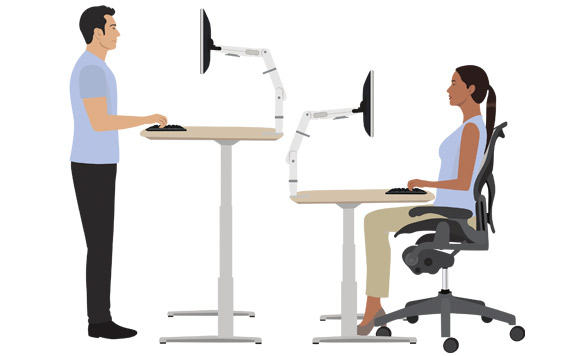by Alex Osborne, Herman Miller –
Talk to any ergonomic consultant and the common theme is that most work environments are not designed to support our tasks and our bodies. Ergonomics in the workplace can be broken down into three branches: physical, cognitive and social. Physical: How are we interacting with the tools required to complete our work? Cognitive: How can we improve the way we process information? Social: Space directly impacts our behaviours – are there a variety of purposeful spaces to support the different ways we work? While these areas have direct overlap, this article will focus on physical ergonomics.
Sit Better: Over 80% of us experience back pain since we sit for most of the day – working, eating, watching TV. Whenever we sit without proper support, our hips roll back and the lower spine unnaturally flattens. A properly adjusted task chair that provides excellent lower spine (sacral) and lumbar support during your work day will have an immediate positive impact. Ensure the height of your chair places your hips at, or slightly above, your knee height. Sit at the back of the chair against the back rest. Keep an approximate four-finger gap from the back of your knees to the front edge of the chair. Too much space increases pressure on your sit bones, too little space will increase pressure behind your knees.
Move Better: The best posture is the next posture. Your body hates prolonged, static postures as we require movement throughout the entire day. A height-adjustable work surface is a fantastic way to increase your movement. They should be the standard for work surfaces everywhere. Why? A standard fixed surface height of 29 inches was originally designed to accommodate the knee heights of most of the population. Unfortunately, this means that the actual working surface is too high for most people. Sit-stand desks are not a trend. They are a necessity to ensure proper working height at any posture. Your work surface should come up to just below your elbows when sitting or standing.
See Better: Shoulder, neck, or eye pain? You might be adopting awkward postures by leaning in to your technology. Many workstations have screens located too far away or too high. The muscles in your eyes responsible for looking up are weaker and fatigue faster than those responsible for looking straight ahead and downwards. Whether standing, sitting upright, or slightly reclined, keep the top third of your monitor at eye level at one arm-length away from your body, and tilt the top edge of the monitor slightly away from you. Since different postures require different monitor positions, invest in a monitor arm to provide ease of adjustability and free up desk real estate.
I am often asked: what is the most important piece of the workstation puzzle? A good chair? A standup desk? The answer is that each tool plays a vital role. Ergonomics is an ecosystem of processes, behaviours and tools that aim to achieve the goal of improving wellbeing, encouraging healthy and dynamic postures, and increasing both employee engagement and productivity.
Looking to change the way you work? Monk Office is Vancouver Island’s exclusive Herman Miller dealer. Visit www.monk.ca for more information.




